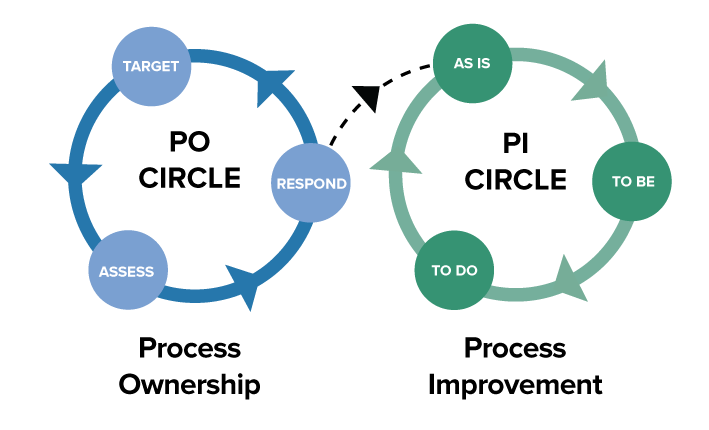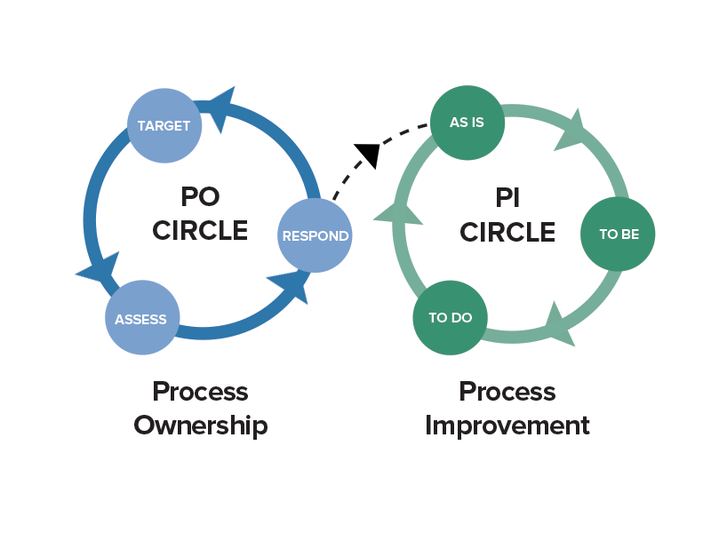 What’s the problem?
What’s the problem?
My favorite question is “What’s the problem we are trying to fix?”— so we should start with that.
In thinking of BPM as a management philosophy, we mean to effect ‘process-based management’. This means that the cross-functional processes that every organization uses to create, accumulate, and deliver value are central to strategic, operational, and tactical management. To do that, we identify the processes, set performance targets, create governance mechanisms, and improve process performance in a process-aware culture where everyone contributes and appropriate support is provided. I have written about and presented this sequence extensively including in a BPTrends column—and also here and here.
We can easily see the required components, and it’s not so hard to imagine them all working harmoniously together in some future state. What is not so easy to see is how to reach this nirvana. How do we get from the pristine theory of everybody being ‘process-centric’, to the gritty reality of managing a real organization with all of its complexities, latencies, impossible demands, and human frailties? How do we operationalize process-based management in a practical and sustainable way?
That’s the problem. Let’s see if you agree that the Circles help provide the answers.
The Circles
First, a recap of the basics of the Circles.
Without conscious attention to cross-functional processes, nobody is responsible for the creation, accumulation, and delivery of value to customers and other stakeholders. The organization chart is silent on this issue. All organizations seek to deliver value but, without a relentless focus on business processes, there is a critical gap between aspiration and reality. Too often, process improvement initiatives are ‘random acts of management’ without a systemic foundation.
PO Circle
The Process Ownership (or PO) Circle is continuously testing for actual or emergent process performance gaps and opportunities. Set a performance target, measure what is happening, explore what could be happening, and respond if the variance is enough to warrant intervention. This target-assess-respond sequence is the essential cycle of process-based management, ensuring unrelenting focus on improving process—hence, organizational performance. For many, this is a new way of thinking and working. The novelty is not in the idea of measurement or reporting, but in measuring and reporting process performance rather than just the performance of organizational units—that is, focusing on value creation pathways from the process architecture, as well as resource-management objects from the organization chart. This is the core of the Process Owner’s[1] role.
PI Circle
The Process Improvement (or PI) Circle identifies the current state (As Is), defines the future state (To Be), and determines and executes the transformation (To Do). Across the spectrum, from small adjustment to significant innovation, the PI circle delivers process performance change. Irrespective of the detailed process analysis methodology employed (the Circles are methodology agnostic), the PI circle addresses the process performance anomalies and opportunities discovered via the PO circle.
Importantly, the PI cycle starts and finishes with As Is. The objective is not to design the To Be, nor is it enough to create the plans for change (To Do). What is required is not just a new To Be or a To Do, but a new As Is. To be credible, process improvement must produce results—that is, improvements in organizational performance. This must be true both for large innovative change and smaller corrective change. While the PO Circle continues to monitor process performance, the PI circle realizes demonstrable and objectively measureable business benefits.
The PI circle discovers the problems we are trying to solve, and opportunities we are trying to realize; it pushes the envelope to find all the possible change ideas, and then executes the best. It is a conscious, deliberate, repeatable process that is applicable for any scale of process change.
Organizations focused on continually improving and innovating their creation, accumulation, and delivery of customer value have process thinking embedded in their culture and practice. The Circles operationalize process-based management.
[1] There are many terms used to describe the Process Owner role, and all of them are wrong in some way. I use the Process Owner term here because it is the most common. I have recently been quite taken with the alternate terms Process Trustee and Process Guardian.




